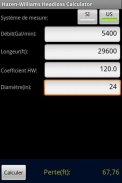




Water Headloss Calculator

Descrizione di Water Headloss Calculator
The Hazen–Williams equation is an empirical formula which calculates pressure drop of water in circular pipes caused by friction. It is used in the design of water pipe systems such as fire sprinkler systems, water supply networks, and irrigation systems.
The Hazen–Williams equation has the advantage that the coefficient C is not a function of the Reynolds number, but it has the disadvantage that it is only valid for water.
Input parameters are flow, pipe diameter, lenght of pipe and C is a roughness coefficient, known as William Hazens coefficient, with values between 90 (more rough pipes) and 140 (smooth pipes, ex PVC).
You can select between imperial (U.S. customary units) and metric unit (International System of Units).
If you want to take into account the pressure loss in fittings and valves, and the selection coefficient C for each material, then find our version of the application pro at https://play.google.com/store/apps/details?id=com.transparentblue.headlossplusL'equazione di Hazen-Williams è una formula empirica che calcola caduta di pressione dell'acqua in condotti circolari per attrito. E 'utilizzato nella progettazione di sistemi di tubazioni di acqua come i sistemi antincendio sprinkler, reti idriche e sistemi di irrigazione.
L'equazione di Hazen-Williams ha il vantaggio che il coefficiente C non è una funzione del numero di Reynolds, ma ha lo svantaggio che è valido solo per l'acqua.
I parametri di input sono di portata, diametro del tubo, lunghezza del tubo e C è un coefficiente di scabrezza, noto come William coefficiente Hazens, con valori compresi tra 90 (tubazioni più grezzi) e 140 (tubi lisci, ex PVC).
È possibile scegliere tra imperiale (unità americane) e unità metriche (Sistema internazionale di unità).
Se si vuole prendere in considerazione la perdita di pressione nei raccordi e valvole, e la selezione coefficiente C per ogni materiale, quindi trovare la nostra versione della pro domanda presso https://play.google.com/store/apps/details?id = com.transparentblue.headlossplus



























